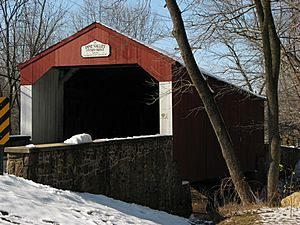List of covered bridges on the National Register of Historic Places in Pennsylvania facts for kids
Have you ever seen a covered bridge? These special bridges look like long, wooden tunnels! They are a big part of history in the U.S. state of Pennsylvania. People built them to help travelers cross rivers and streams safely.
In the early 1800s, the very first covered bridge in the United States was built in Philadelphia. It was designed by Timothy Palmer and crossed the Schuylkill River. Why cover a bridge? Well, Pennsylvania winters can be very harsh! Stone bridges, common in Europe, didn't hold up well to the snow, ice, and freezing temperatures. Covering the wooden parts of the bridge protected them from the weather. This made the bridges last much longer. Many of these old bridges were named after the pioneer families who lived nearby.
Because Pennsylvania has so many of these unique bridges, some people even call it the "Covered Bridge Capital of the Nation"!
Contents
What is a Covered Bridge?
A covered bridge is a special type of bridge that has a roof and sides. It looks a bit like a barn or a tunnel. The main reason for covering these bridges was to protect the wooden parts underneath. Wood can rot or get damaged by rain, snow, and sun. By covering the bridge, builders made sure it would last for many, many years. This was very important in the days before modern materials like steel and concrete.
Why Were They Covered?
Imagine a wooden deck or porch outside. Over time, the wood gets worn out by the weather, right? It's the same for bridges! The roof and walls of a covered bridge acted like a giant shield. They kept the main structure, called the "truss," safe from the elements. This protection meant the bridges didn't need as many repairs and could stay strong for a long time.
Different Bridge Designs
Builders used different designs, or "trusses," to make these bridges strong. Some common types you might hear about are:
- Burr truss: This design uses a strong arch combined with a crisscross pattern of timbers.
- Kingpost truss: This is a simpler design with a central vertical post and angled supports.
- Queenpost truss: Similar to the kingpost, but with two vertical posts and diagonal supports.
- Town truss: This design uses many crisscrossing wooden planks, like a lattice.
- Howe truss: This design uses both wood and iron rods for strength.
Each design helped the bridge hold up heavy loads and last through tough weather.
Pennsylvania's Historic Covered Bridges
Many of Pennsylvania's covered bridges are very old and important. They are listed on the National Register of Historic Places. This is like a special list of buildings, places, and structures that are important to American history. When a bridge is on this list, it means it's recognized for its historical value and is often protected.
Pennsylvania is home to many beautiful and historic covered bridges. These bridges are found all over the state, from small towns to quiet country roads. Each one tells a story about the past and how people traveled long ago. They are a wonderful reminder of early American engineering and craftsmanship.


